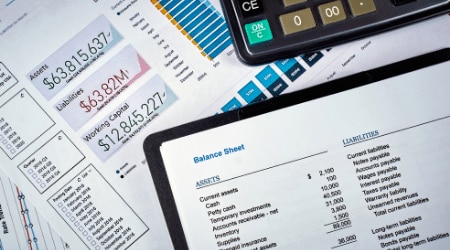The Financial Accounting Standards Board (FASB) has formulated certain widely accepted rules, standards, or procedures for companies to report accounting information. These are called Generally Accepted Accounting Principles (GAAP) that are used by companies to prepare financial statements to record and report accounting information.
As per GAAP, every business entity is required to prepare the Balance Sheet at the end of an accounting period along with the other fundamental financial statements. These include Profit and Loss and Cash Flow Statement.
Such financial statements provide useful information to both internal and external stakeholders regarding financial soundness, performance, and changes in the financial position of a business entity.
Thus, a simple Balance Sheet gives a true and fair view of your business’s financial position.
In this article, we will learn a simple balance sheet definition, how a balance sheet works, balance sheet formula, balance sheet template, elements of the balance sheet, and how to make a balance sheet template.
What is a Balance Sheet and How Do You Prepare One?
A Simple Balance Sheet is one of the three fundamental financial statements that give a snapshot of the financial position of your business entity at the end of an accounting period.
It basically showcases your company’s assets, liabilities, and shareholder’s equity as on a specific date. That is, what your company owns, the amount it owes together with the amount that is invested by its shareholders.
Furthermore, the Balance Sheet is also referred to as a Statement that showcases Sources of Funds and the Application of Funds.
This is because your business requires resources that have a longer life, that is, more than one year. Such resources can be acquired via funding provided either by you as an owner or a group of owners in the form of your investments, by banks in the form of loans, or by suppliers in the form of credit.
Thus, a Simple Balance Sheet exhibits a list of resources (assets) and how such resources are funded (liabilities). So, given the above-mentioned views, a Classified Balance Sheet is prepared by recording the sources of funds (liabilities + owner’s equity) on the left-hand side, and the application of such funds (assets) on the right side of the T-Account.
This means that every dollar invested in your business entity’s assets is either provided by the owners or the creditors. Accordingly, the sum total of assets must be equal to the sum total of liabilities and the owner’s equity.
Overview: Balance Sheet Definition
As per Balance Sheet definition, a Balance Sheet is one of the fundamental financial statements that provide a true and fair view of your business entity’s financial position as of a specific date. It showcases assets, liabilities, and owner’s equity at a specific point in time.
In other words, a company Balance Sheet is a financial statement that calculates the worth of your business (equity) by deducting the amount that your business entity owes (liabilities) from the amount that it owns (assets).
How Does a Balance Sheet Work?
There are two views that can help us in understanding the impact of economic events on the company balance sheet.
Resources and Claims View
According to this view, assets are resources that your business entity owns on a specific date. These resources provide benefits to your business entity for a long period of time, that is, more than one year.
On the other hand, liabilities are the amounts that your business entity owes to external stakeholders like banks, creditors, etc. And Owner’s Equity is nothing but the capital that belongs to you as an owner.
Sources and Use of Funds
As per this view, assets are nothing but the resources that are acquired by your business entity to be utilized over a long period of time. Whereas, the liabilities and owner’s equity are the funds through which such resources have been acquired.
Now, taking both the views into consideration, we come to the following simple balance sheet formula or balance sheet equation based on which the company balance sheet is prepared:
Assets = Liabilities + Owner’s Equity
Where,
Assets = Current Assets + Non-Current Assets
Liabilities = Current Liabilities + Non-Current Liabilities
Owner’s Equity = Share Capital + Retained Earnings
Thus, as per this equation, the following is the Balance Sheet accounts:
- Assets
- Liabilities and
- Owner’s Equity
Do I Need a Balance Sheet?
A Company Balance Sheet is one of the important financial statements that reveal important insights to both the internal as well as external stakeholders. Thus, such a statement helps them in making informed financial decisions.
There are various reasons why you as a business entity need to prepare a balance sheet and thus know how to make a balance sheet :
Strategic Decision Making
It gives you an understanding of where your business stands at any specific date. Thus, by knowing the financial health of your business, you can make some important strategic decisions.
For instance, in case the sum total of assets is less than the total of liabilities and shareholder’s equity, it is an indication that you need to reduce the amount you owe to the outsiders.
This could include either increasing the sources of revenue, putting in more capital, or collecting payments from debtors.
Availing Loans and Advances
Balance Sheet Accounts allow banks to understand whether your business is financially sound enough to avail loans and advances.
Thus, by calculating the Debt-Equity ratio, they can know if extending additional loans to your business would be safe or risky.
Identifying the Trends
The Balance Sheets of several accounting periods help you as a business entity to identify the trends in the various items listed on the Balance Sheet.
For instance, you as a business entity can know how much your business has grown over a given period of time.
Short-Term Financial Standing
You can see the current assets against the current liabilities and get an understanding of the short-term financial health of your business entity.
Accordingly, you can know if you have sufficient funds in the short-term to pay off or meet your short-term obligations like operating expenses, supplier payments, etc.
How to Read a Balance Sheet?
There are certain things that you must keep in mind in order to read a new Balance Sheet properly. These are as follows:
What Makes a Balance Sheet?
As stated above, a new Balance Sheet is divided into three parts:
- Assets
- Liabilities and
- Owner’s Equity
The detailed elements of the Balance Sheet are given below under the heading elements of a Balance Sheet.
Balance Sheet Equation
We know that the Balance Sheet is based on the balance sheet formula which states that Assets must be equal to Liabilities plus Owner’s Equity.
This is because the claims of both the creditors as well as the owners against your business entity must equate to the amount that you have invested in various business assets.
In other words, the worth of your business, that is equity, is nothing but the difference between everything that you own in the form of assets and the amount that you owe to the outsiders in the form of liabilities.
Balance Sheet Format
Typically, both the asset and the liability side of the Balance Sheet are structured based on how current the assets and liabilities are?
That is, in the case of assets, the most liquid assets such as cash, inventory, etc are recorded first on the top of the new Balance Sheet. Whereas, the least liquid assets like plant and machinery, land and building, etc, are recorded at the bottom.
Likewise, in the case of liabilities, the short-term liabilities like creditors, short-term loans and advances, etc are recorded at the top of the new Balance Sheet. Whereas, the long-term liabilities including long-term loans and advances are showcased at the bottom.
The Role of the Balance Sheet in Financial Statements
As stated earlier, GAAP requires business entities to prepare a Balance Sheet at the end of an accounting period. Basically, there are three important financial statements that every business entity needs to prepare, each having its own purpose.
- A balance Sheet is a financial statement that gives a snapshot of your business entity’s financial position at a particular point in time. It reveals the resources that your business entity has or owns (assets) and the claims of both the creditors (liabilities) and owners (shareholders equity) against such resources. It is a financial statement that provides useful insights to both the external and internal stakeholders about your entity’s financial status that further helps them in making informed financial decisions.
- The income statement, on the other hand, is a financial statement that provides the users of such statement information regarding the amount of profit or loss your business entity has earned or incurred during an accounting period. Further, it helps in determining how the profit or loss was generated or incurred by your business entity. For instance, the Gross Profit figure helps you to keep a check on the cost of goods and services that you provide as a business entity. Likewise, operating profit tells your ability as a business entity to earn a profit before taking into account the impact of the financing activities.
- The Cash Flow Statement showcases cash inflows and cash outflows for an accounting period of your business entity to the user of such a statement. It provides insights to the users such as investors who can understand the cash-generating ability of your business entity and how cash is utilized.
The Balance Sheet Formula
The Balance Sheet is based on the following Accounting Equation where assets on one side of the equation equal to the Liabilities and Shareholder’s Equity on the other side. So, let’s try to understand what this Balance Sheet formula means.
Your business entity has to get funds for everything that you own (assets). You can fund these assets either by borrowing it from the creditors, taking loans from banks (in other words taking liabilities), or avail these funds from investors (shareholder’s equity).
Say, for instance, you as a business entity take a seven-year loan for plant and machinery worth $10,000. As per the double-entry system of accounting, your cash account would increase by $10,000. On the other hand, the Loan Account would also increase by $10,000, thus balancing both sides of the Balance Sheet.
Furthermore, the assets, liabilities, and the shareholder’s equity can be further divided into current assets, current liabilities, long-term assets, and long-term liabilities. These vary depending upon the industry you are into and the same terms can mean different things depending on the type of business you are into.
Elements of the Balance Sheet
If you take a Balance Sheet sample, there are three major Balance Sheet Accounts. These include:
- Assets
- Liabilities
- Owner’s Equity
Each of these is further broken down into sub-items. Let’s have a look at each of them.
Assets
Assets are the resources owned by your business entity that provide you with economic benefits in the long run. These are further categorized into current assets and noncurrent assets.
Current Assets
Current Assets are the assets that can be converted into cash within one year or a normal operating cycle of your business entity, whichever is longer. Operating Cycle is nothing but the time it takes you as a business entity to buy your produced inventory, sell the finished goods, and collect cash for the same.
There are a number of current assets that form part of your company’s balance sheet. These include:
- Cash
- Marketable Securities
- Accounts Receivables
- Inventories
- Prepaid Expenses
Non-Current Assets or Fixed Assets
The Non-Current Assets are the assets that cannot be easily converted into cash in the normal course of business. They are long term assets that have been purchased for providing goods or services and are not meant for resale to earn profits.
The Non-Current Assets can be further subdivided into tangible non-current assets like plant and machinery, property, long-term investments, etc., and intangible non-current assets like goodwill, copyright, etc.
Liabilities
Liabilities are nothing but the money that you owe as a business entity to your creditors, lenders, and equity owners against the assets of your business entity. These can be further grouped into current liabilities and non-current liabilities.
Current Liabilities
These are the liabilities that are required to be paid off within the normal operating cycle of the business or within one year, whichever is longer. Current Liabilities include:
- Accounts Payables
- Accrued Expenses
- Current Portion of Long-Term Debt
- Deferred Revenues
Non-Current Liabilities
These are the liabilities that are due for payment for more than one year. These include:
- Long-Term Borrowings
- Deferred Tax Liabilities
- Long-Term Provision
Owner’s Equity
Owner’s Equity is nothing but the amount invested by the investors in your business entity. Thus,
Owner’s Equity = Paid-In Capital + Retained Earnings
This means that increase in your business earnings would ultimately lead to an increase in owner’s equity.
Example of a Balance Sheet
Following is the Balance Sheet sample of Star Enterprises Pvt Ltd as of December 31, 2019.


